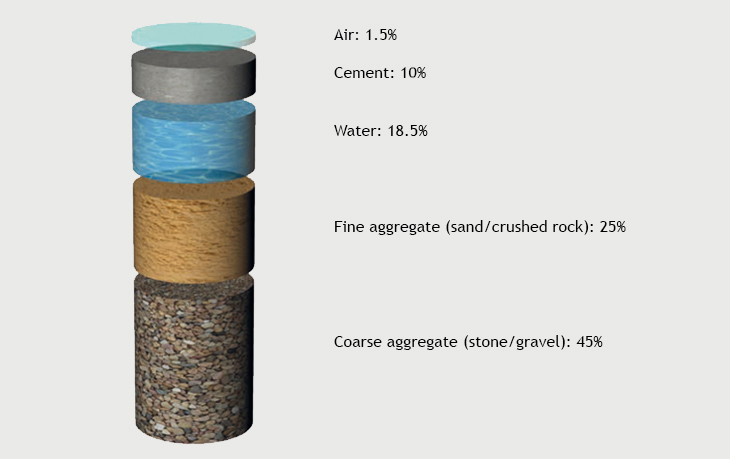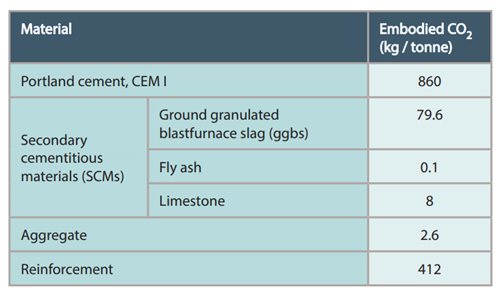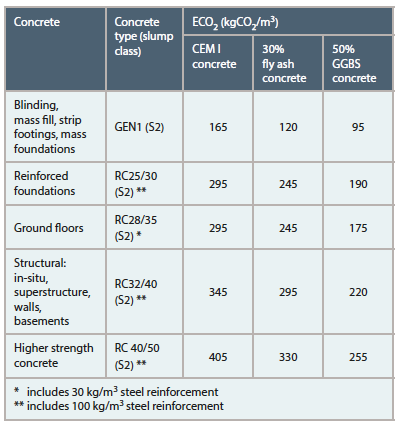Concrete Compass: Low carbon concrete
Navigating to useful resources and guidance

Concrete is a low carbon, local and responsibly sourced material and is widely used throughout the construction industry due to its durability, versatility and fire resistance. In this Concrete Compass on low carbon concrete, we explore concrete specification and provide guidance to support designing in low carbon concrete. The embodied carbon of a structure can also be reduced through structural design and lean design, this is covered in our Material Efficiency Compass.
Our latest published guidance on low carbon concrete is in the article The Formula in Concrete Futures: Spring 2023.
Key guidance
- Specifying Sustainable Concrete - This publication assists designers in optimising the sustainable credentials of concrete through specification. The guide focuses on concrete, its constituent materials and how the variation of specification can influence embodied carbon; the performance of fresh and hardened concrete (e.g. strength gain, durability); the use of recycled/secondary materials as well as information on responsible sourcing and assessment methods.
- Whole-life Carbon and Buildings - Concrete frame construction provides a durable structure, which is a fundamental aspect of whole-life performance. But less understood is its compelling whole-life CO2 performance, resulting from several attributes largely unique to concrete buildings. These are the focus of this guide, which sets out the ways in which these attributes can be used to minimise CO2 emissions.
Low embodied carbon constituents
Concrete is a low carbon material. Its versatility, performance and local availability has resulted in it being the second most consumed material globally (after water). The potential to reduce global carbon emissions, by reducing the embodied carbon of such a widely used material are not in doubt.
As shown in the figure above, the majority of the volume of concrete is aggregates that are low in embodied carbon. The majority of the embodied carbon of concrete comes from the binder, the cementitious material - this can be Portland cement (CEM1) or secondary cementitious materials, such as GGBS, FA or limestone. Secondary cementitious materials have a lower embodied carbon and can be used in combination with CEM1, as permitted in BS 8500. The embodied carbon of the constituent materials of concrete is published in Specifying Sustainable Concrete. More detail on cementitious materials can be found in MPA Cement's Factsheet 18.

Table 10: Embodied CO2 for main constituents of reinforced concrete, Specifying Sustainable Concrete, 2020
Lower embodied carbon concrete
Concrete is a unique material in that the specifier has the ability to directly influence the constituent parts of the mix to ensure an optimum carbon footprint that meets performance criteria and addresses the design imperatives of resource and energy efficiency within a whole life context, that also address the precepts of a circular economy.

Table 11: Embodied CO2 of designated concretes showing the influence of different cements, Specifying Sustainable Concrete, 2020
Related resources that may be of interest include:
- With concrete you can cut carbon now and also cut future carbon with the decisions you make now - this is explored in Target Zero article of Concrete Quarterly magazine, autumn 2019.
- Read more about new or novel cements covered by PAS 8820:2016
Lowest whole life carbon
In addition to embodied carbon and operational carbon, designers need to consider the total, whole-life carbon. Whole-life carbon emissions are the most holistic measure of the total impact of our built environment and can help to avoid unintended consequences of focusing on embodied or operational carbon alone. The reason it is not referred to more, is that it is more complicated to measure than embodied and operational carbon. A methodology for determining whole-life carbon is set out in EN 15978:2011 Sustainability of Construction Works and at a product level the consistent measure for EPDs is EN 15804.
To assist with whole-life assessment and design of concrete buildings, The Concrete Centre has published a guide entitled Whole-Life Carbon and Buildings, which sets out the specific qualities of concrete construction that can be used to help minimise carbon impacts including:
- Operational energy - using the thermal mass provided by concrete to lower operational emissions.
- Designing for long life - the longevity of concrete allows a building’s useful life to be extended; a key tenet of whole-life thinking and a circular economy.
- Reuse and adaptability - reducing whole-life CO2 through the ability to reuse concrete structures.
- End-of-life - the absorption of CO2 into concrete through the natural process of carbonation.
Decarbonising cement and concrete
The UK concrete and cement industry has reduced the embodied carbon of concrete, per tonne, by 30% (since 1990) and reports annually on its progress to decarbonise. The absolute carbon emissions reduction of the UK cement and concrete industry is 53% compared to 1990. No Offsets Required from Concrete Futures magazine (2020) discusses how the concrete and cement industry is working towards a carbon-negative built environment, without offsetting.
In 2020, the UK concrete and cement industry published the Roadmap to Beyond Net Zero by 2050, this superseded an earlier decarbonisation roadmap published by the UK cement sector in 2013. The latest roadmap provides a viable route that uses seven key decarbonisation technology levers to go beyond net zero.
 In October 2020, the UK Concrete and Cement industry published its Beyond Net Zero roadmap. The roadmap provides a pathway to beyond net zero with an achievable and viable route that uses seven key decarbonisation technology levers. Download the Roadmap to Beyond Net Zero
In October 2020, the UK Concrete and Cement industry published its Beyond Net Zero roadmap. The roadmap provides a pathway to beyond net zero with an achievable and viable route that uses seven key decarbonisation technology levers. Download the Roadmap to Beyond Net Zero
Net zero can be met through a blend of these levers, which include decarbonised electricity and transport networks, fuel switching, greater use of low-carbon cements and concretes, as well as advanced carbon capture technology. Many of these levers are already proven technologies, while others will require collaboration and input from more than one industry. Most will need to be supported by local and central Government over the long term, and critically all will require concerted action and investment.
At this stage, the roadmap represents our best course for achieving and going beyond net zero. However, as we approach 2050 it may prove to be the case that we can dial up or down certain levers depending on our progress.
The UK concrete industry reports annually on a range of sustainability indicators as part of the Concrete Industry Sustainable Construction Strategy. The Strategy was first launched in 2008 and featured targets to be met in 2012. In 2012 the strategy was updated with targets set for 2020, and an updated strategy with 2030 targets is in development. A commitment of the strategy is to publish data on the performance of the concrete industry, across a wide range of indicators including biodiversity, responsible sourcing, waste minimisation, wellbeing and carbon emissions.
The data collection for the concrete industry report includes data from BAR, on behalf of the reinforcement sector; UKQAA, on behalf of the fly-ash sector; CSMA, on behalf of the GGBS sector and the CAA, on behalf of the admixtures sector. The Concrete Industry Sustainable Construction Strategy and annual performance reporting has a dedicated website at www.sustainableconcrete.org.uk.
 Back to Concrete Compass main page
Back to Concrete Compass main page